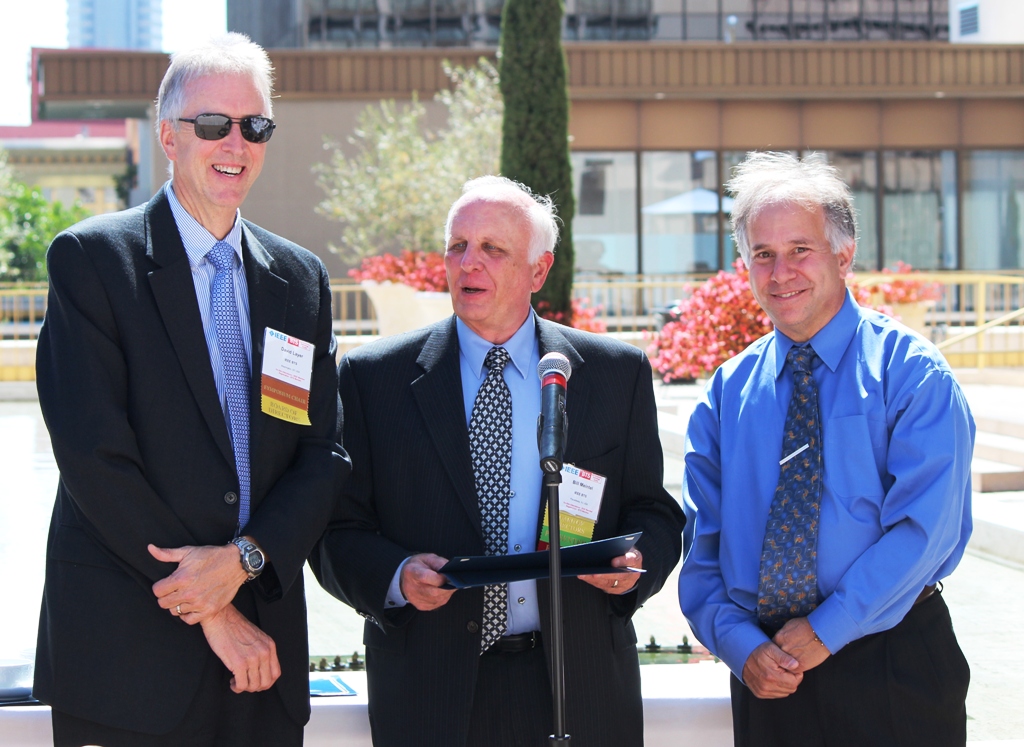IEEE BTS Symposium Examines Television’s Move to UHD

IEEE BTS president Bill Meintel (center) presents certificates of appreciation to Symposium organizers David Layer (l) and Paul Shulins (r) in an outdoor lunch time awards ceremony.
SAN DIEGO, CALIF. — Broadcast engineers convened last week to discuss new innovations in broadcast technology and to explore what the future has in store for one-to-many communication. The forum was the annual Institute of Electrical and Electronic Engineers’ Broadcast Technology Society fall Symposium, with the Oct. 9-11 event attracting more than 110 participants from the United States and nine foreign countries.
Technical presentations, tutorial sessions and roundtable discussions covering such topics as over-the-air 4K video transmission, ATSC next-generation television system development progress, single frequency network broadcasting technology, implementation of Mobile DTV EAS, and new video coding technologies highlighted the three-day event held at the Westgate Hotel here.
WHERE TV IS HEADING
Just as at this year’s NAB and IBC Shows, 4K video was a hot topic at the Symposium. This was underscored by a tutorial presentation from InterDigital’s Dr. Yan Ye on HVEC, which will likely be required to accommodate transmission of ultra high-definition video to the home. Young-Woo Suh from the Korean Broadcasting System reported on experiments in over-the-air transmission of 4K video in Korea, and PBS’s James Kutzner, in his progress report on development of the proposed ATSC 3.0 television standard, noted that it included transmission of UHD television. The need for better and more realistic audio to accompany these rising video resolutions was not neglected at the Symposium, with presentations on new audio technologies and techniques that will be needed for next-generation television broadcasting from Dolby’s Jeffrey Riedmiller, DTS’s Jean-Marc Jot, and Graham Jones, who is a consultant for Fraunhofer.
CHANGE OF VENUE
The San Diego Symposium marked the first time in the event’s 63-year history that it has been held outside the Washington, D.C. area. The move reflected an effort by the BTS to try and stimulate interest in the Symposium and raise attendance by making it more accessible to West Coast broadcast engineers. (Plans are in place to hold the 2014 Symposium in San Antonio, Texas.)
Symposium co-chair, Paul Shulins, commented on the new location: “This was a big experiment and we’re very pleased with the turnout. We’re seeing a lot of familiar faces, but we’re also seeing some new faces, which was our real goal—to expose the Symposium to some new people. The venue is wonderful and the people are wonderful here, and we’re hoping to expand it again next year when we move it to Texas.”
This year’s Symposium sponsors included Wheatstone, ERI, Organ, Sony, the Telos Alliance, Sierra Automated Systems, NewTek, Dielectric, Harris Broadcast, Jampro Shively Labs, Radio Frequency Systems, Myat, Canon, Kintronic Labs, Tieline, Richland Towers, Qualcomm, BSW, Comrex, SCMS, and duTriel, Lundin & Rackley.
Details about the 2013 Symposium and future Symposium events may be found on the BTS website.
Get the TV Tech Newsletter
The professional video industry's #1 source for news, trends and product and tech information. Sign up below.
James E. O’Neal has more than 50 years of experience in the broadcast arena, serving for nearly 37 years as a television broadcast engineer and, following his retirement from that field in 2005, moving into journalism as technology editor for TV Technology for almost the next decade. He continues to provide content for this publication, as well as sister publication Radio World, and others. He authored the chapter on HF shortwave radio for the 11th Edition of the NAB Engineering Handbook, and serves as editor-in-chief of the IEEE’s Broadcast Technology publication, and as associate editor of the SMPTE Motion Imaging Journal. He is a SMPTE Life Fellow, and a Life Member of the IEEE and the SBE.

